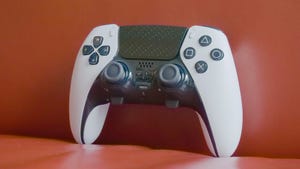
Hands-On With Sony's DualSense Edge Controller for PlayStation 5 - CNET
The DualSense Edge controller is the latest accessory for Sony’s PlayStation 5, and it offers a high degree of customization at an equally high price. The PS5’s default controller, the DualSense, got its name from its ultraspecific vibration functionality. The Edge is a pro-style controller that improves on that by allowing players more options to fine-tune their inputs and, as Sony explains, “craft [their] own unique gaming experience tailored to [their] playstyle.” However, this enhanced customization doesn’t come cheap.
While a typical PS5 controller will cost you around $70, the new DualSense Edge, which comes with some accessories, is $200. Alongside the controller itself, the box includes a carrying case with a pass-through window to allow for charging, a USB-C cable and a connector housing to secure it to the controller, plus two separate options for back paddles and two options for analog stick replacements.

The DualSense and DualSense Edge controller look very similar to one another at first glance. The controllers even weigh just about the same, with the DualSense coming in at around 281 grams while the Edge is slightly more at approximately 325 grams.
The Edge features a textured grip on the handles that helps the controller stay in your hands. It also has grooves on the trigger buttons, which is nice because you can more easily keep your fingers in the proper position. Textures and grooves aside, when the back buttons are removed, the controllers feel almost identical to use. The original DualSense has a notoriously short battery life, around 7 to 10 hours. From my brief testing, I’m disappointed to report that the Edge comes in at an even lower 5 to 7 hours. The included USB-C is pretty long so, fortunately, I could still play games while the controller charged.

More buttons, more options
Pro controllers give players more options for how the buttons and triggers register inputs. When connecting the controller to the PS5 for the first time, a welcome screen shows the different customization options from both a hardware and software perspective. On the hardware side, players can attach either half-dome (rounded and short) or lever (skinny and long) back paddles to the device. These paddles sit close to where the player’s middle or ring fingers rest and can be mapped to any other input on the DualSense Edge. First-person shooter fans often use these to keep their right thumb on the right analog stick so they can aim while still being able to jump or duck (an input often put on the X or O face buttons). While both paddles are comfortable to use, I prefer the half-dome option since it sits a bit further away and can’t be as easily pressed by mistake.
These back paddles are also a great accessibility feature. Players with low range of motion for any of the primary controller fingers (the thumbs or pointer fingers) can swap one of those inputs to the back of the controller where they might have an easier time pressing a button.

The next biggest hardware tweak is in the trigger buttons on top of the controller. Next to each trigger is a mechanical switch that adjusts how much the L2/R2 buttons can be pressed before registering a full push. Players can choose between three ranges of motion. Fans of twitch-based games often prefer shorter distances so they can press quicker and more often. For example, being able to shoot a gun more rapidly will give Call of Duty players an advantage. Microsoft’s Xbox Elite controller has similar options for its triggers and paddles.
Customizing the software
Customization options are set via the PS5 accessories settings screen, and the intensity and deadzone customization options are the most exciting. These menus can adjust how fast the input curves are for any of the controller’s analog inputs. For example, if you want to physically use the full range of the trigger buttons but want the controller to register that input more quickly, you can fine-tune that on a surprisingly granular level. This goes for the analog sticks’ movement, as well. In addition, you can adjust the deadzone (the center part of the stick where the controller registers no input) to be wider.
All of these software options can be saved into a user profile. The DualSense Edge features two Fn (function) buttons, located below the analog sticks. Holding either of them down and pressing any of the face buttons will let you toggle between four assigned profiles. It seems like a missed opportunity that both of these buttons do the same thing when held down and don’t have the ability to map different commands to each one. That said, being able to swap between profiles midgame was quite useful, especially when jumping between different games. For example, Fortnite and Overwatch have different crouch buttons, so using the same profile wouldn’t be helpful.

The DualSense Edge fills a hole that was missing from PlayStation’s portfolio. The controller feels good and offers new and more personal ways for any player to connect with a game, but its high price means it only makes sense for the truly dedicated.
This review is in progress, and we’ll update with additional impressions and a video later this week.

